|
COP11
BIOLOGICAL DIVERSITY 2012
PLEASE USE OUR A-Z INDEX
TO NAVIGATE THIS SITE
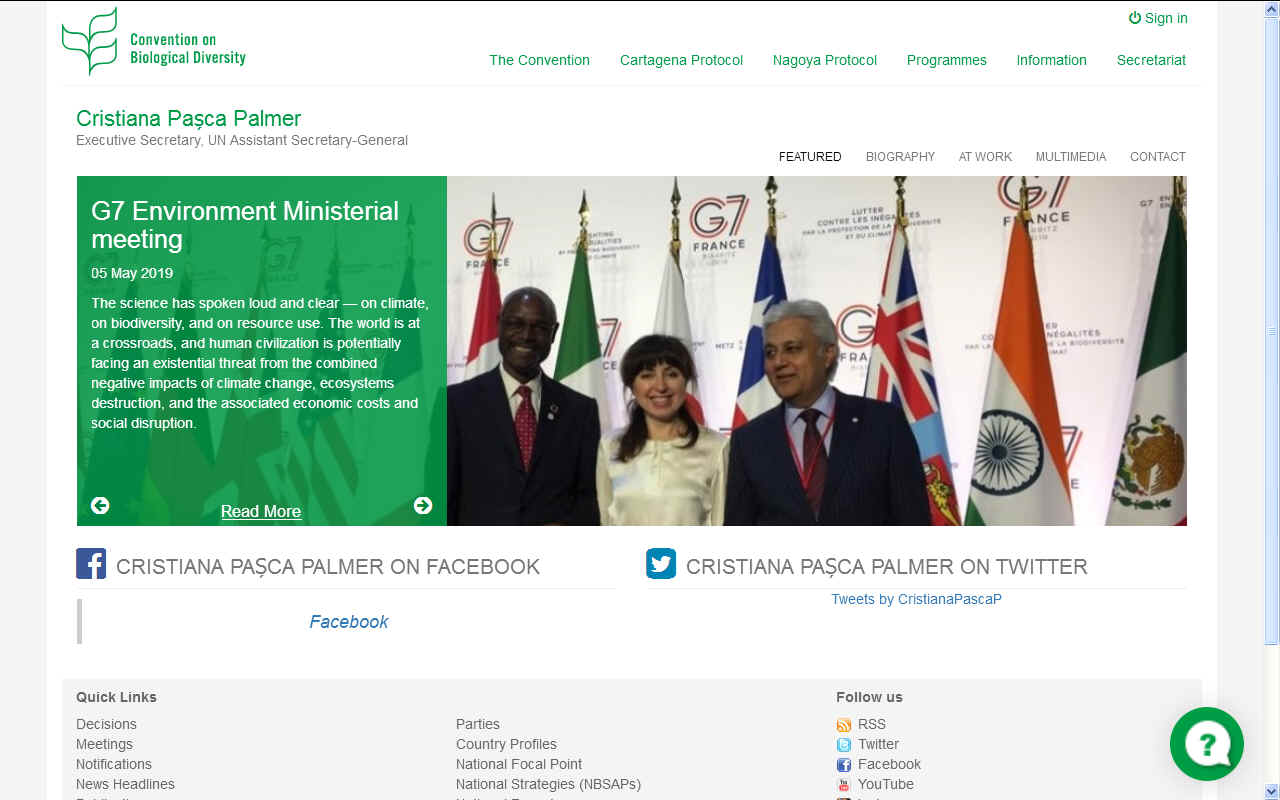
COP
11 the eleventh ordinary meeting of the parties to the convention took place in Hyderabad,
India in 2012.
Leading up to the Conference of the Parties (COP 11) meeting on biodiversity in Hyderabad, India 2012, preparations for a World Wide Views on Biodiversity has begun, involving old and new partners and building on the experiences from the World Wide Views on
Global
Warming.
At COP 11, decision XI/17, Parties welcomed the reports of the first two regional workshops for describing ecologically or biologically significant marine areas (EBSAs), held in the Western South
Pacific and in the Wider
Caribbean and Western
Mid-Atlantic, pursuant to decision X/29, paragraph 36.
Parties requested the Executive Secretary to include the summary reports of this first series of EBSA workshops in the EBSA repository and to submit them to the
United Nations General Assembly so that they could be considered by relevant UN processes linked to the
United Nations Convention on Law of the Sea, in particular the
United Nations General Assembly Working Group, which is considering the development of an international agreement for biodiversity conservation in marine areas beyond national jurisdiction. Parties also requested the Executive Secretary to organize additional regional or
sub-regional EBSA workshops where Parties wish workshops to be held.
Also in decision XI/17, Parties to the Convention called for more research into the potential adverse effects on marine and coastal biodiversity of underwater noise from ships and highlighted the growing concern on the adverse effects of
marine
litter. Parties also recognized the growing impacts of climate change on
coral reefs and agreed, that overcoming this challenge would require significant efforts. Decision XI/17 also contained a call to fisheries management bodies to play a stronger role in addressing the impacts of fisheries on biodiversity. The series of agreements at COP 11 on
oceans and coasts built on the commitment countries made at the
United Nations Rio+20 summit in June to protect and restore marine ecosystems and to maintain their biodiversity.
SUBSIDIARY
BODY ON SCIENTIFIC TECHNICAL AND TECHNOLOGICAL ADVICE
The
fifteenth and sixteenth meetings of the SBSTTA took place in Montreal,
Canada, 7 - 11 November 2011 and 30 April - 5 May 2012
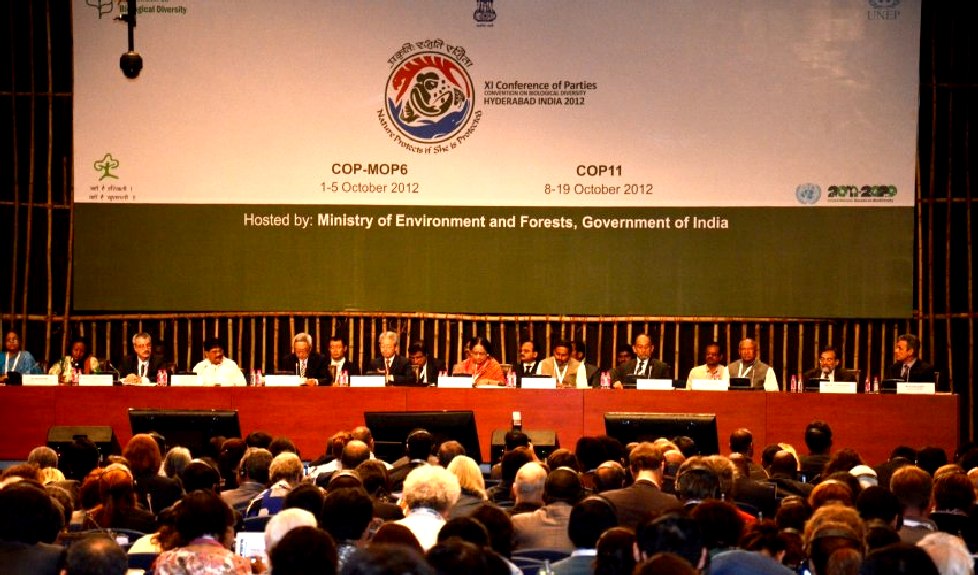
IUCN
SOS - SAVE OUR SPECIES
An estimated 5000 delegates from all over the globe have congregated at the CBD COP 11 venue in this historic Indian city to find solutions to the most pressing issues facing biodiversity conservation.
Mr. Hoshino Kazuaki - representative of the Ministry of Environment, Japan and Mr. Ryu Matsumoto - former minister for Environment declared the opening of the CoP11 and handed over the presidency to Ms. Jayanthi Natarajan - Minister of Environment and Forests, Government of India.
Ms. Natarajan in her opening remarks stated the need for all parties to mobilize resources to achieve the 20 Aichi Biodiversity Targets which are part of the strategic plan agreed at COP 10 in Nagoya,
Japan in 2010. Speaking on the occasion she said, "We have been provided a singular opportunity to collectively decide the allocation of resources to generate momentum to achieve the Aichi targets - expenditure on biodiversity needs to be looked at as an investment for future generations and not as costs".
In his opening remarks, CBD Executive Secretary Mr. Braulio Ferreira de Souza stressed on the need to put in energy and resources into implementing the Aichi targets. Speaking on the occasion, Mr. de Souza urged the parties to ratify the convention within the next COP.
Addressing the inaugural session of the COP11, de Souza drew linkages between global business sector and the Aichi targets. "I urge you to mobilize the financial resources to enable developing countries to achieve the 2020 targets" he said. He also called on urgent attention to all parties and stakeholders to ensure the implementation of at least half of the targets by 2015 if significant progress was to be achieved by the end of the decade.
Speaking at a side event on IUCN's contribution to the Aichi Biodiversity Targets on October 9, Jane Smart - head of IUCN delegation and Global Director of IUCN Biodiversity Conservation Group and Species Program remarked that the IUCN knowledge products support the implementation of the 2020 Aichi biodiversity targets which underpins the entire IUCN program for 2013-2016. The event discussed on how IUCN's Aichi roles and policy could contribute to the articulation and delivery of the targets in countries.
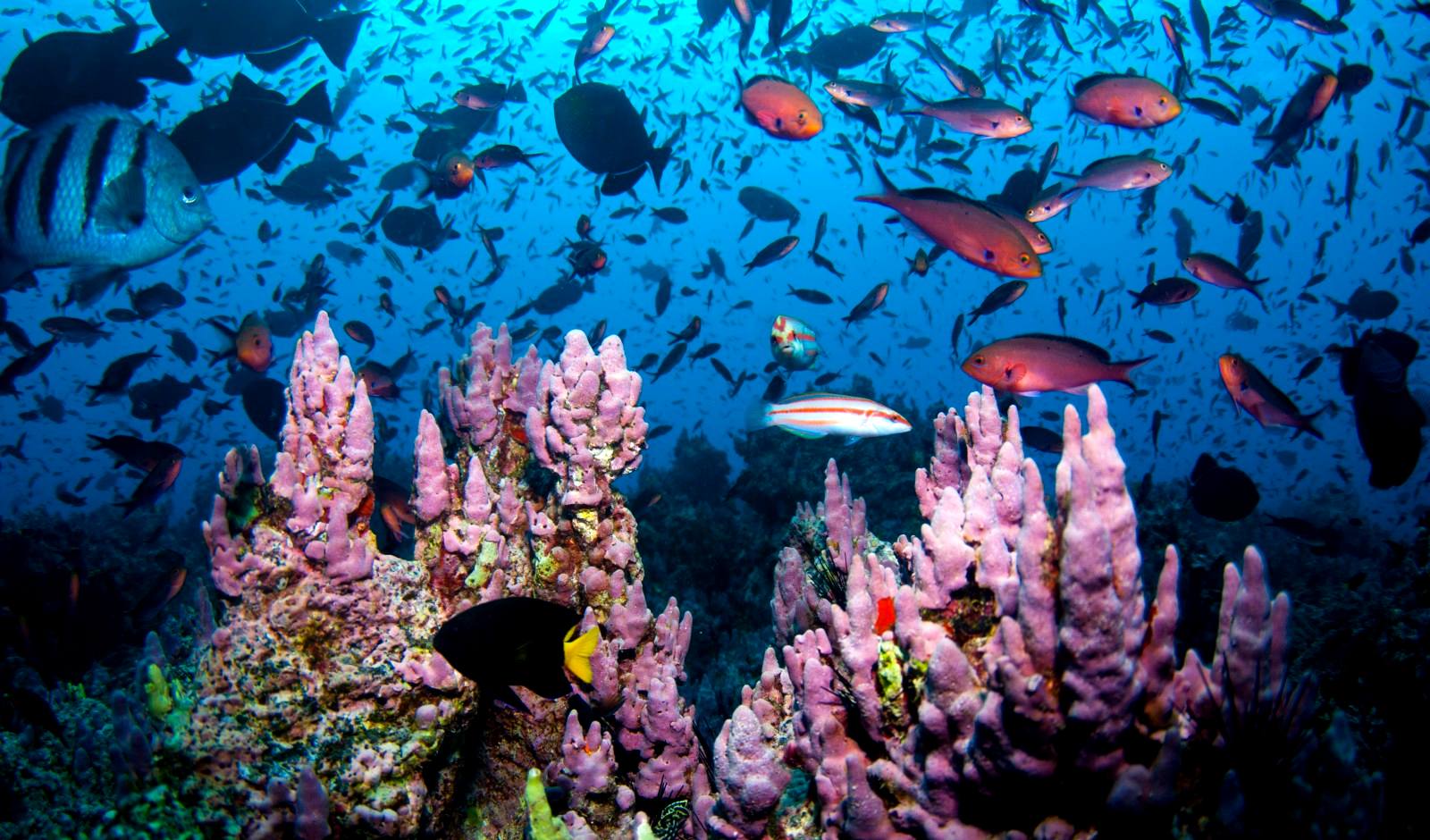
PARTIES
TO THE CONVENTION
As of 2016, the
Convention
on Biological Diversification had 196 parties, which includes 195 states and the European
Union. All UN member states - with the exception of the United
States - have ratified the treaty.
The
United Nations is the link between other Conferences of the
Parties to include Climate
Change and Desertification.
It is a bit confusing to have so many different conferences
that deal with interconnected issues. In addition, each member
state will have their own meetings on the subject to decide
what their position will be at the COPs. We wonder then at the
size of the carbon
footprints so generated in relation to the effectiveness
of the decisions - that at the moment do not appear to be
working to stabilize our climate, stop deserts from being
created, or protect the habitats of our species.
In
our view a climate emergency should have been declared, to
accelerate a change from fossil
fuels to clean energy harvesting. Not only to protect
coral and other endangered species, but also to ensure long
term energy
security for the parties.
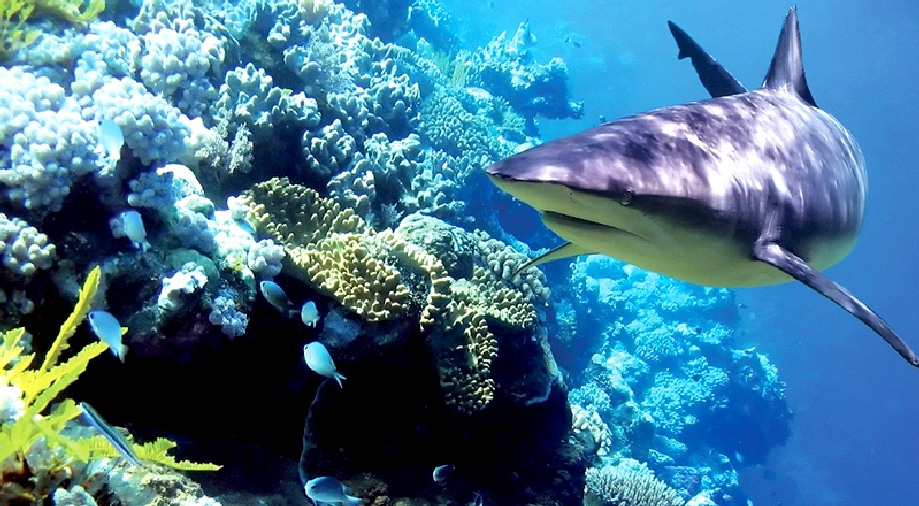
CONFERENCES
OF THE PARTIES
The convention's governing body is the Conference of the Parties (COP), consisting of all governments (and regional economic integration organizations) that have ratified the treaty. This ultimate authority reviews progress under the Convention, identifies new priorities, and sets work plans for members.
The Conference of the Parties (COP) uses expertise and support from several other bodies that are established by the Convention.
The main organs are:
(a)
review of progress in implementation;
(b) strategic actions to enhance implementation;
(c) strengthening means of implementation; and
(d)
operations of the convention and the Protocols.
National Reports
Parties prepare national reports on the status of implementation of the Convention.
MARINE & COASTAL BIODIVERSITY
The oceans occupy more than 70% of the Earth’s surface and 95% of the biosphere.
Life in the sea is roughly 1000 times older than the genus Homo.
There is broad recognition that the seas face unprecedented human-induced threats from industries such as
fishing and transportation, the effects of waste disposal, excess nutrients from
agricultural runoff, and the introduction of exotic species.
If we fail to understand both the vulnerability and resilience of the living sea, the relatively brief history of the
human species will face a tragic destiny.
What's the Problem?
According to the Millennium Ecosystem Assessment, the world’s oceans and coasts are highly threatened and subject to rapid environmental change. Major threats to marine and coastal ecosystems include:
* Land-based pollution and euthrophication
* Overfishing, destructive
fishing, and illegal, unreported and unregulated (IUU) fishing
* Alterations of physical habitats
* Invasions of exotic species
* Global climate change
CONTACTS
Cristiana Pașca
Palmer
Secretariat of the Convention on Biological Diversity
413, Saint Jacques Street, suite 800
Montreal QC H2Y 1N9
Canada
Tel: +1 514 288 2220
Fax: +1 514 288 6588
E-Mail: secretariat@cbd.int
Web: www.cbd.int
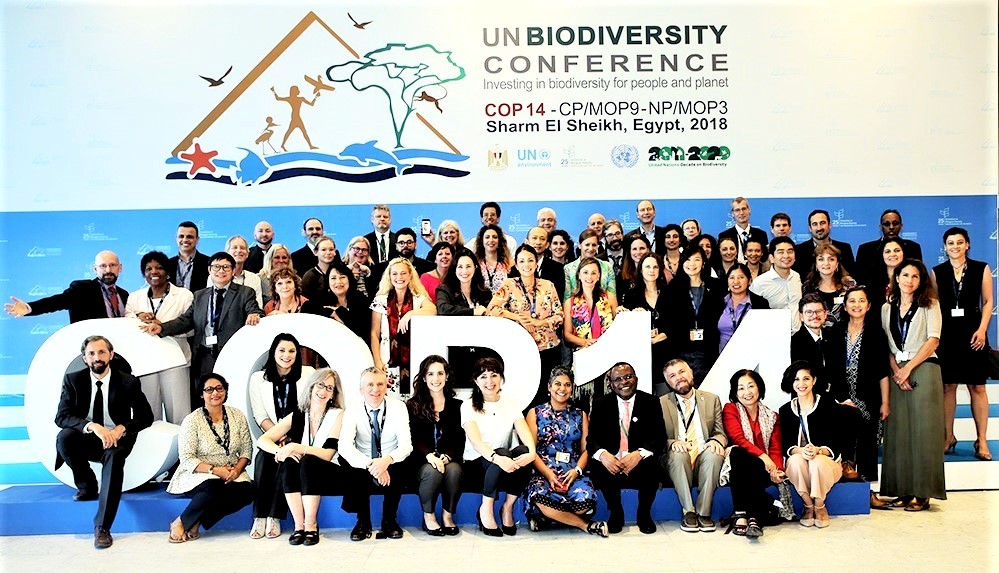
BIODIVERSITY
COP HISTORY
|
COP
1: 1994 Nassau, Bahamas,
Nov & Dec
|
COP
8: 2006 Curitiba, Brazil, 8
Mar
|
|
COP
2: 1995 Jakarta, Indonesia,
Nov
|
COP
9: 2008 Bonn, Germany,
May
|
|
COP
3: 1996 Buenos Aires, Argentina,
Nov
|
COP
10: 2010 Nagoya, Japan,
Oct
|
|
COP
4: 1998 Bratislava, Slovakia, May
|
COP
11: 2012 Hyderabad, India
|
|
EXCOP:
1999 Cartagena, Colombia, Feb
|
COP
12: 2014 Pyeongchang, Republic of Korea, Oct
|
|
COP
5: 2000 Nairobi, Kenya, May
|
COP
13: 2016 Cancun, Mexico,
2 to 17 Dec
|
|
COP
6: 2002 The Hague, Netherlands,
April
|
COP
14: 2018
Sharm El-Sheikh, Egypt, 17 to 29 Nov
|
|
COP
7: 2004 Kuala Lumpur, Malaysia, Feb
|
COP
15: 2020 Kunming, Yunnan, China
|
CLIMATE
CHANGE UN COP HISTORY
|
1995
COP 1, BERLIN, GERMANY
1996
COP 2, GENEVA, SWITZERLAND
1997
COP 3, KYOTO, JAPAN
1998
COP 4, BUENOS AIRES, ARGENTINA
1999
COP 5, BONN, GERMANY
2000:COP
6, THE HAGUE, NETHERLANDS
2001
COP 7, MARRAKECH, MOROCCO
2002
COP 8, NEW DELHI, INDIA
2003
COP 9, MILAN, ITALY
2004
COP 10, BUENOS AIRES, ARGENTINA
2005
COP 11/CMP 1, MONTREAL, CANADA
2006
COP 12/CMP 2, NAIROBI, KENYA
2007
COP 13/CMP 3, BALI, INDONESIA
|
2008
COP 14/CMP 4, POZNAN, POLAND
2009
COP 15/CMP 5, COPENHAGEN, DENMARK
2010
COP 16/CMP 6, CANCUN, MEXICO
2011
COP 17/CMP 7, DURBAN, SOUTH AFRICA
2012
COP 18/CMP 8, DOHA, QATAR
2013
COP 19/CMP 9, WARSAW, POLAND
2014
COP 20/CMP 10, LIMA, PERU
2015
COP 21/CMP 11, Paris, France
2016
COP 22/CMP 12/CMA 1, Marrakech, Morocco
2017
COP 23/CMP 13/CMA 2, Bonn, Germany
2018
COP 24/CMP 14/CMA 3, Katowice, Poland
2019
COP 25/CMP 15/CMA 4, Santiago, Chile
2020
COP 26/CMP 16/CMA 5, to be announced
|
DESERTIFICATION
COP HISTORY
|
COP
1:
Rome, Italy, 29 Sept to 10 Oct 1997
|
COP
9:
Buenos Aires, Argentina, 21 Sept to 2 Oct 2009
|
|
COP
2:
Dakar, Senegal, 30 Nov to 11 Dec 1998
|
COP
10:
Changwon, South Korea, 10 to 20 Oct 2011
|
|
COP
3:
Recife, Brazil, 15 to 26 Nov 1999
|
COP
11:
Windhoek, Namibia, 16 to 27 Sept 2013
|
|
COP
4:
Bonn, Germany, 11 to 22 Dec 2000
|
COP
12:
Ankara, Turkey, 12 to 23 Oct 2015
|
|
COP
5:
Geneva, Switzerland, 1 to 12 Oct 2001
|
COP
13:
Ordos City, China, 6 to 16 Sept 2017
|
|
COP
6:
Havana, Cuba, 25 August to 5 Sept 2003
|
COP
14:
New Delhi, India, 2 to 13 Sept 2019
|
|
COP
7:
Nairobi, Kenya, 17 to 28 Oct 2005
|
COP
15:
2020
|
|
COP
8:
Madrid, Spain, 3 to 14 Sept 2007
|
COP
16: 2021
|
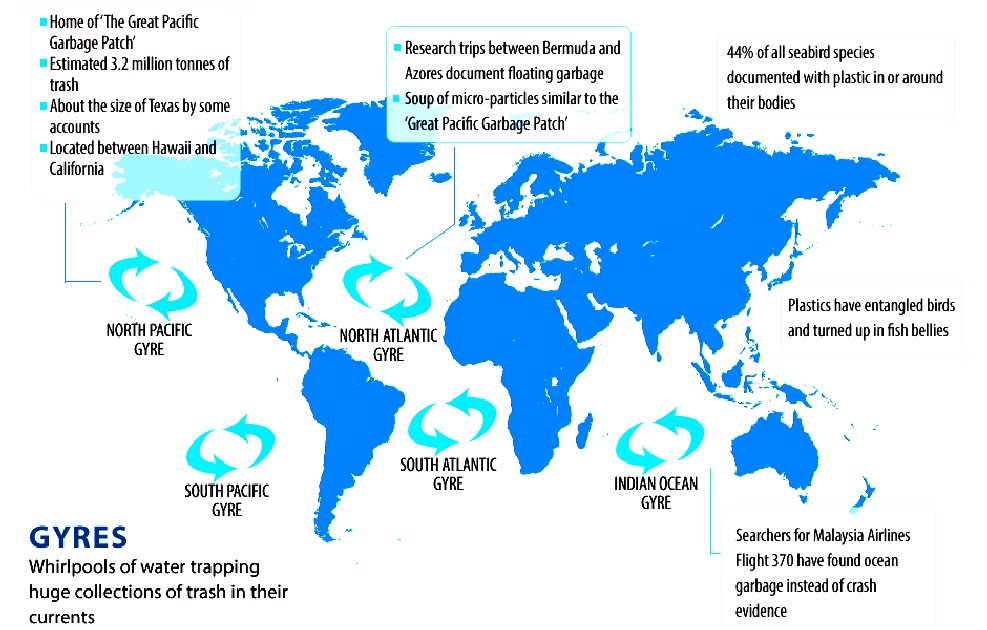
CONSERVATION
RISK
-
Plastic has accumulated in five ocean hot spots called
gyres, see here in this world map derived from information
published by 5 Gyres. The plastic is laden with toxins that
fish and marine mammals mistake for food and eat - eventually killing them.
Marine pollution is thus a major challenge if we are to ensure that species are
not wiped out.
LINKS
& REFERENCE
https://www.saveourspecies.org/news/cbd-cop-11-underway-hyderabad-aichi-biodiversity-targets-2020-gets-center-stage
https://www.cbd.int/meetings/SBSTTA-01
https://worldoceanreview.com/en/wor-1/marine-ecosystem/biodiversity/
https://www.cbd.int/executive-secretary/
https://www.cbd.int/marine/
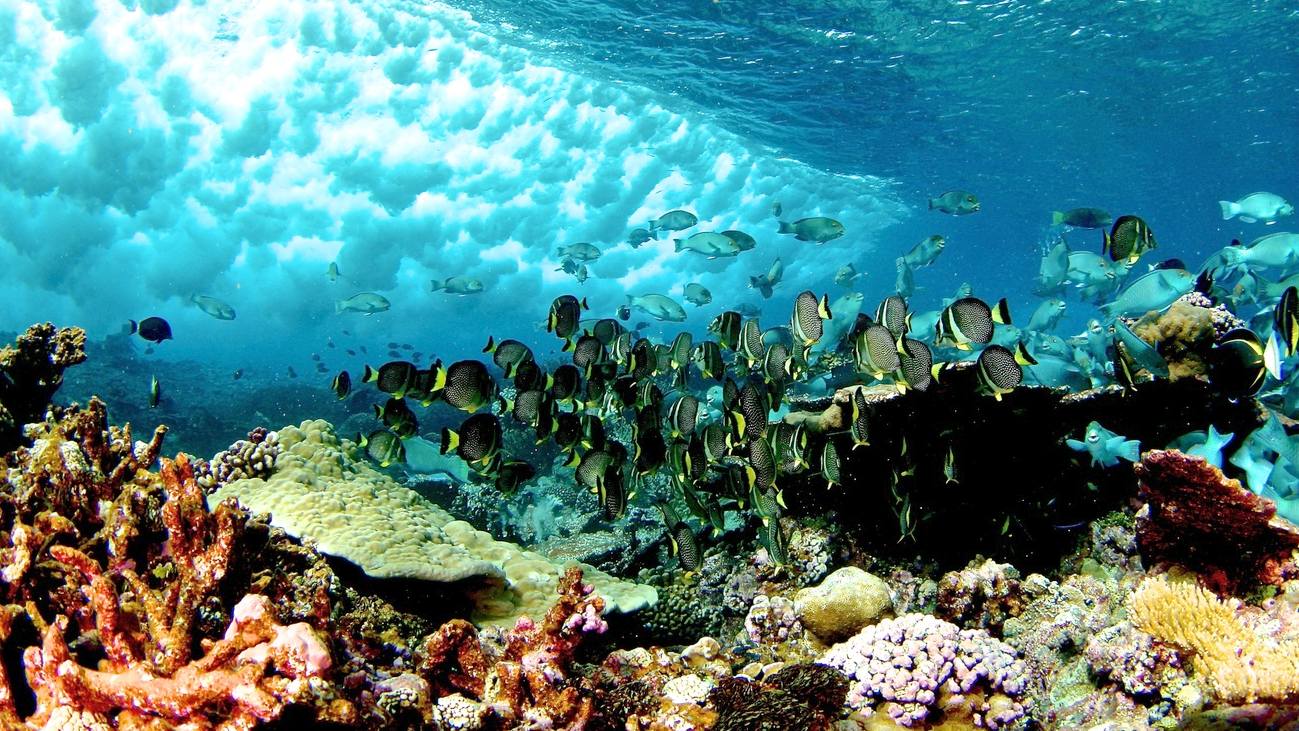
This website is
provided on a free basis as a public information service. copyright © Cleaner
Oceans Foundation Ltd (COFL) (Company
No: 4674774) 2019. Solar
Studios, BN271RF, United Kingdom.
COFL is
a company without share capital.
|






